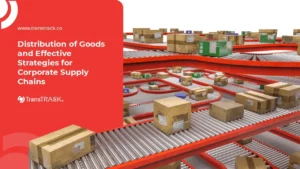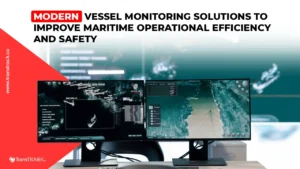Find Out Why Supply Chain Visibility is Important for Business Efficiency!
Posted on September 24, 2025 by Nur Wachda Mihmidati

The ability to track the flow of goods and information in real-time determines the success of logistics operations. Supply chain visibility allows companies to see the entire supply chain process, reduce risks, reduce costs, and ensure customer satisfaction is maintained. With the right visibility, operational decisions can be faster, more accurate, and have a strategic impact. Find out more through the following article TransTRACK!
What is Supply Chain Visibility?
Supply Chain Visibility (SCV) or Supply Chain Visibility is the ability of a company to track and monitor the entire flow of goods, information, and processes in the supply chain in real-time. The goal is to get an end-to-end view of every stage in the supply chain, from suppliers, production, transportation, to distribution to end customers.
Business Problems Without Supply Chain Visibility
Without adequate visibility, companies face various challenges that can compromise their operational efficiency, reputation, and ability to respond to market changes.
High Operational Costs
Uncertainty in stock, delivery, or demand means companies often incur additional costs, for example for emergency deliveries or extra storage. This can reduce profitability and hinder business growth.
Reputation and Compliance Risk
Inability to monitor the supply chain can lead to delivery delays, defective products or regulatory violations. As a result, companies can lose customer trust and face sanctions from relevant authorities.
Difficult to Respond to Disruptions
Without visibility, companies struggle to make quick decisions when disruptions occur, such as supplier delays or changes in market demand. This makes the company’s response reactive instead of proactive, increasing the potential for losses.
Benefits of Supply Chain Visibility for Companies
With full visibility of the supply chain, companies can make more informed decisions, improve efficiency, and build customer trust.
Inventory Optimization & Production Planning
Supply chain visibility allows companies to know their stock in real-time and predict production needs more accurately. This reduces the risk of excess or insufficient inventory, while improving operational efficiency.
Compliance with Standards and Regulations
Thoroughly monitoring the flow of goods and processes helps companies ensure all activities comply with regulations and industry standards. Thus, the risk of legal sanctions or adverse audits can be minimized.
Improve B2B and B2C Customer Satisfaction
With accurate delivery and stock information, companies can fulfill customer requests on time and improve service transparency. As a result, customer loyalty increases.
Reduce Logistics and Transportation Costs
Supply chain visibility helps companies identify areas of waste and optimize delivery routes. This directly lowers transportation costs and improves overall efficiency.
Technology Supporting Supply Chain Visibility
To gain full supply chain visibility, companies are leveraging various advanced technologies that are capable of monitoring, analyzing, and optimizing the flow of goods and information.
Cloud-based SCM Platform
Cloud-based supply chain management (SCM) systems allow inventory, delivery and production data to be accessed in real-time from anywhere. This facilitates coordination between teams and increases the speed of decision-making.
AI & Predictive Analytics
Artificial intelligence and predictive analytics help companies project demand, identify risks, and plan production more efficiently. Thus, companies can respond to market changes before problems arise.
IoT, RFID, and Blockchain
IoT and RFID technologies enable real-time tracking of goods, while blockchain provides secure and transparent transaction records. This combination increases data accuracy and trust of all parties in the supply chain.
Supply Chain Visibility Implementation Strategy
Building supply chain visibility requires a well-planned strategy, from process mapping to technology adoption and collaboration with business partners.
Supply Chain Audit and Mapping
The first step is to evaluate the entire supply chain process to identify weak points and potential risks. The results of this audit form the basis for improvement planning and technology implementation.
Collaboration with Suppliers and Logistics Partners
Visibility is only effective when all parties in the supply chain work together and share data transparently. This collaboration improves coordination, speeds up response to disruptions, and reduces operational costs.
Digital System Integration & Employee Training
Combining digital systems, such as SCM or IoT platforms, with employee training ensures technology is used optimally. This makes the decision-making process faster, more accurate and sustainable.
Conclusion
Supply chain visibility is not just a trend, but a strategic necessity for companies looking to improve efficiency, reduce costs, and maintain customer satisfaction. With full visibility, companies can monitor the flow of goods and information in real-time, respond quickly to disruptions, and ensure regulatory compliance. Proper implementation, supported by advanced technology and collaboration with partners, will provide a real competitive advantage.
FAQ about Supply Chain Visibility
1. What is the difference between supply chain visibility and supply chain transparency?
Supply chain visibility focuses on a company’s ability to monitor the flow of goods and information in real-time, while supply chain transparency emphasizes opening up information to all relevant parties, including customers and the public.
2. How to improve supply chain visibility?
Increase visibility by mapping the supply chain, integrating digital systems, using technologies such as IoT and AI, and collaborating with suppliers and logistics partners.
3. What does supply chain visibility have to do with cost efficiency?
With full visibility, companies can optimize inventory, reduce emergency deliveries, and improve production planning, resulting in reduced operational and logistics costs.
4. What industries need supply chain visibility the most?
Industries that rely on complex supply chains and just-in-time delivery, such as logistics, manufacturing, agriculture, mining, and retail, are in dire need of visibility to maintain efficiency and customer satisfaction.
Improving supply chain visibility is a strategic move for companies to strengthen operational efficiency, reduce costs, and increase customer satisfaction. With real-time monitoring and proper data integration, companies can respond to disruptions faster and ensure the smooth running of the entire logistics process.

Optimize your supply chain now with TransTRACK’s Logistic Service Integrator – an end-to-end solution that combines digital systems, smart analytics, and fleet coordination for more efficient and transparent logistics operations.
Recent Post
Topic :
Recommended Articles

 Bahasa Indonesia
Bahasa Indonesia







